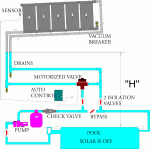I'd have to look up the exact range for my Heliocol panels. But I'm using 5 GPH for each panel, times 8 panels = 40 GPH. The calculation is based on the manufacturer's spec for each panel, times the number of panels. I'd expect that each panel size, and manufacturer, will have its own number. I have a FlowVis, so I just watched it as I adjusted my VS pump's RPMs. Super easy.
If a VS is not in your future, you can plumb a bypass in your system that can reduce the flow of water through your panels. That won't cost much (a valve or two and some PVC). Something like this, though I wouldn't want ball-valves in my system:

In this example, the 2 isolation valves are not part of the bypass, only that one horizontal valve is. But before I did that, I might try fooling with the three-way valve that sends water to the panels. They can be adjusted to not open or close fully. So I would set mine, when it's in "solar heat" mode, to channel some water to the panels, and some back to the pool without going thru the panels. That should reduce the flow rate through the panels. Might be worth a try before replumbing anything. What I can't predict is if that will actually improve the heat exchange at the panels enough to compensate for the water you're not heating (the water bypassing the panels). I think it should.
The reason a second bypass valve is preferred is because it's not handy to adjust the three-way. You have to disassemble them and fool with cams inside, then put them back together (plus figure out what you're doing!). So a dedicated bypass valve is
much easier to fine tune.
Of course, a VS is the optimal solution. Have you considered installing one? They do pay for themselves over time (and in a lot of cases, not much time). So you'd be able to optimize your heater, and save energy costs whether the heater is off or on.
Does your system have a check valve? There are some brands that accept the guts of a FlowVis. A FlowVIs doubles as a check valve. FlowVis sells a couple variations: one that is the entire assembly, check valve and flow meter and body, and another that is just "the guts" that you screw onto the body of an existing check valve. You might save some dough that way if you're interested in installing a flow meter.


